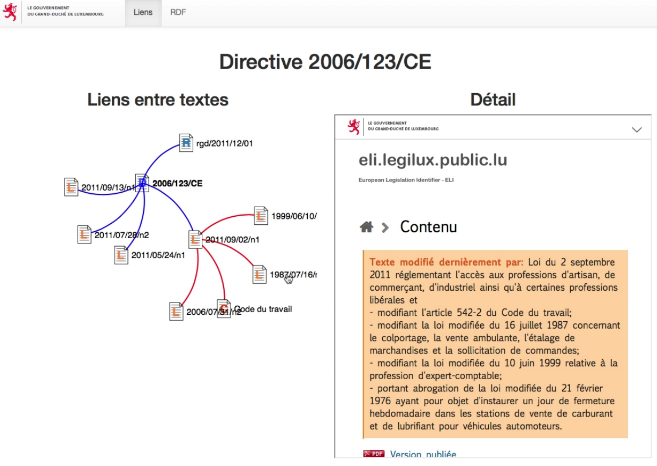Success Story: Visualising legislation
SCL, Luxembourg’s central legislation service, has assigned ELIs to all legislation it has ever published. However, this is currently limited to identifying whole acts. Future activities, including assigning ELIs for specific articles, are in the planning phase.
The ‘persistent’ identification of legislation offers certain benefits. For example, identifiers can be used to show the relationships between laws by:
- linking amendments to original acts
- linking acts and amendments to consolidated versions
- linking national laws to the EU directives they transpose.
SCL is testing a visualisation tool that shows these relationships in a map-like interface. Using this powerful visual method, civil servants and decision-makers will be able to see the complicated interrelations between legal texts, while machine-readable data will help them understand these relations.
Visualising national and EU legislation
-
Figure a): EU directive as starting point

-
Figure b): Links to national legislation

-
Figure c): Specific national law related to directive

-
Figure d): Amendments to national law

Figure a) shows a particular directive
Figure b) shows the visual representation of national legislation linked to the directive
Figure c) shows a particular national law
Figure d) shows other national legislation such as earlier versions that have been since amended.
If a law or directive is amended, this visual representation makes it very easy to see straight away which other laws could be affected. Legal experts will no longer lose time working out the relationships between acts: with this visual interface, the time it takes them to see the connections goes from hours to seconds.
Having such a clear overview of the relationships between laws and directives will not only benefit the Luxembourgish administration's legal services. It will also:
- help the European Commission itself to check the transposition of EU directives
- be useful to lawyers advising their clients
- be of interest to the general public.
Currently, the interface shows only relationships between whole acts. If we increase granularity when assigning ELIs to include identification of articles and clauses, the visual representation will be more powerful as it will enable a fine-grained network of relations shows precisely how different parts are related.
Using ELI-compliant HTTP URIs with a compliant ELI ontology has advantages for all stakeholders and potential users. ELI HTTP URIs are:
-
web-based
ELI HTTP URIs are web-based identifiers. They build on the web’s existing resolution mechanism. When ELIs are assigned to web-accessible information, you can follow a relationship just by clicking on a link.
-
stable
ELI HTTP URIs are designed to identify legal acts in a persistent way. ELI HTTP URIs do not break, so these kinds of visualisation services can be built based on the persistence of the identifier and the resource it identifies. This means that both the administration and third parties can build services based on ELI HTTP URIs with greater confidence than if they were using non-persistent URIs.
-
granular
ELI HTTP URIs make it possible to be very precise when identifying acts and parts of acts. The more precise the ELIs, the more powerful the visual representations and other applications will become. This strengthens the case for assigning and using these identifiers.
-
machine-processable
ELI uses a conceptual modelling approach to define the concepts and relationships between legal acts and make it easier for everyone to understand them. Because ELI is based on a formal specification, it is directly machine-processable. This means that it can be represented in visualisation tools.


